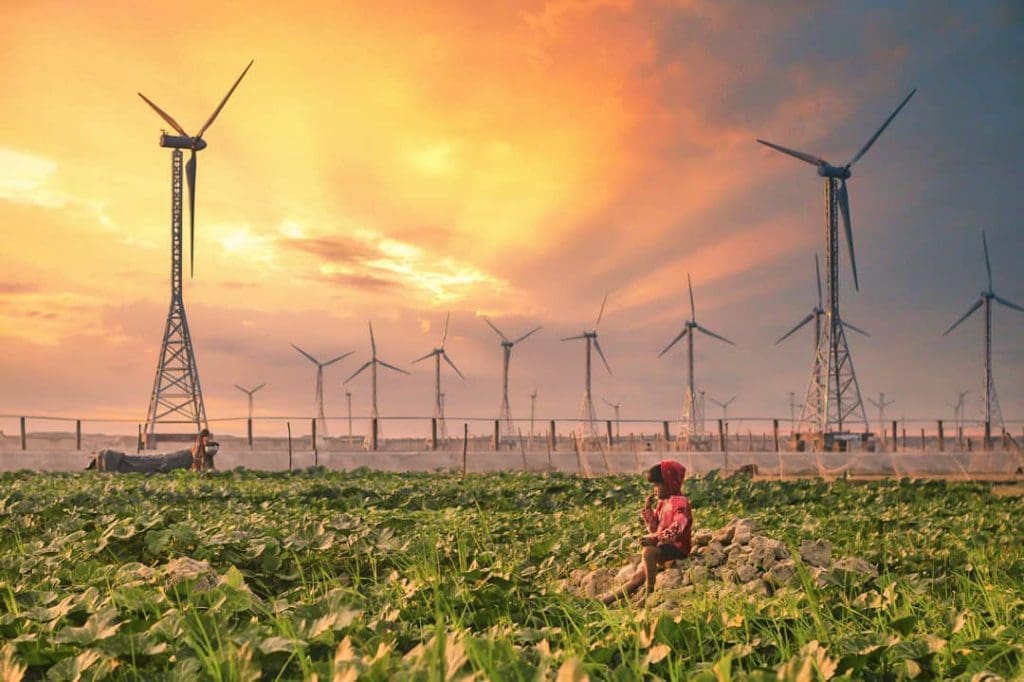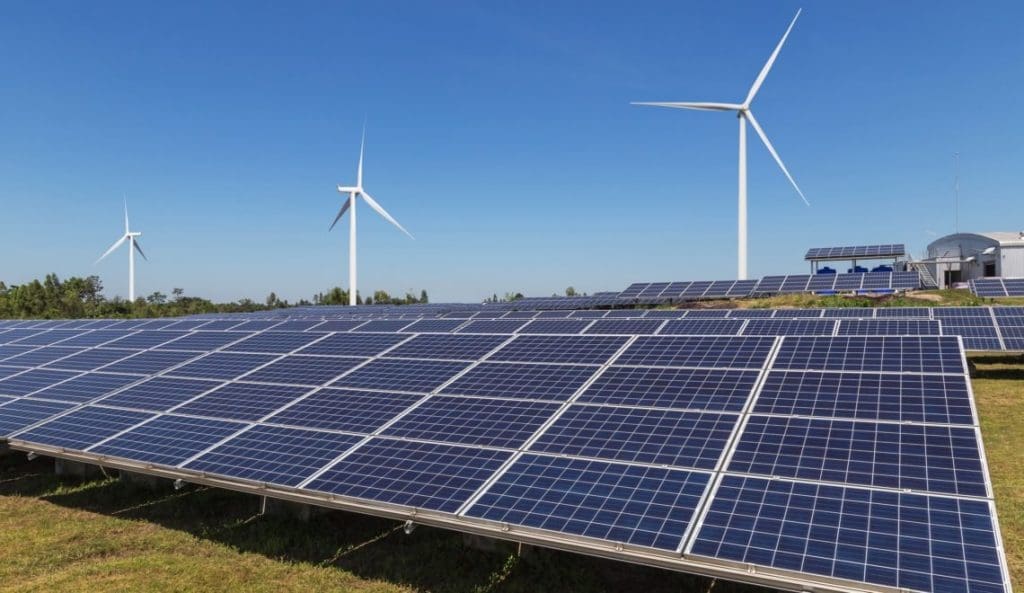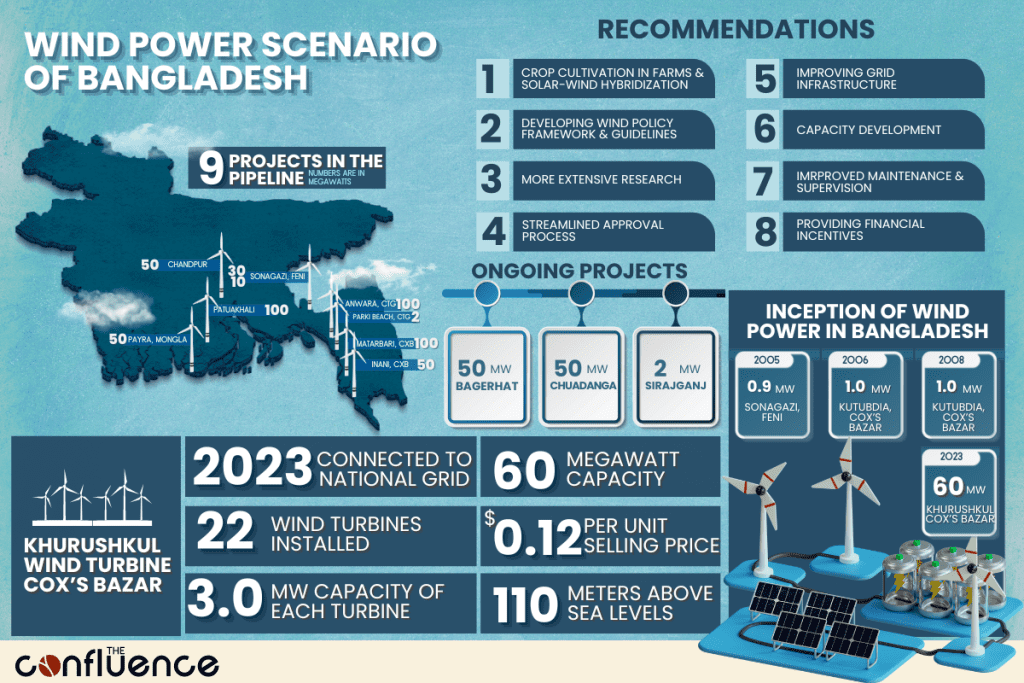Wind power is now the second least expensive source of electricity, following natural gas. Even though Bangladesh’s wind power potential was surrounded with skepticism in the past, several studies have showcased the country’s dormant prospects for generating wind power. Recently a 60MW wind power plant has started operating at full capacity.
According to the U.S.-based National Renewable Energy Laboratory (NREL), Bangladesh possesses a substantially greater potential for wind power, particularly at a hub height of 140 to 160 meters. In addition to having a 724-kilometer-long coastline, the country also has many small islands, each of which is capable of capturing the powerful winds that are generated in the country’s northeastern region, particularly during the winter season. Regions such as the Bay of Bengal, Kuakata, Sandwip, and St. Martin – have the highest potential for producing electricity from wind power.
Annual Wind Speed Range in Bangladesh’s Coastal Areas
2.96 – 4.54 m/s
In Kuakata’s coastal belt
5.5 – 9.5m/s
In Chittagong region
According to a study by the Local Government Engineering Department, the annual wind speed in Kuakata’s coastal belt ranges between 2.96 meters per second and 4.54 meters per second. According to statements from power officials, several regions of the country, particularly Chittagong, have consistent wind speeds ranging from 5.5 to 9.5 meters per second at an elevation of 20 meters above ground level for a significant portion of the year.
As Bangladesh navigates its way through the global energy crisis, largely (but not entirely) caused by Russian invasion of Ukraine and OPEC’s decision to slam oil production, renewable energy sources, especially wind, will be pivotal in diversifying the country’s energy mix and ensuring energy security. Construction of both onshore and offshore wind power plants will not only ameliorate the sufferings of energy poor off-grid communities but also add an extra supply of power to the national grid. Additionally, the offshore wind farm projects will allow Bangladesh to maximize the utilization of its coastal resources while furthering the progress of a ‘blue economy’.
0
% of 12%
Target of renewable energy (% of total consumption) achieved
Unrealized Previous Targets
5% of total consumption
By 2015
10% of total consumption
By 2020
On the other hand, in order to achieve SDGs, Bangladesh is required to generate 12% of its total energy supply from renewable sources, which is currently only 2%. Previously the government targeted to generate 5% of the country’s total energy demand from renewable sources by 2015 and 10% by 2020, both of which were not realized within the targeted period.
Moreover, finance for energy sustainability projects is comparatively easier to achieve given that the LDC graduation of Bangladesh will make the country ineligible for many other forms of concessional loans. Given the necessity of attracting FDIs in Bangladesh on its way to progress, investing on energy sustainability can prove to be a boon for the economy in the longer run.
Policy Support by GoB
Policy Framework and Targets
1370 MW Targeted
Renewable energy production by 2030
5 GW Targeted
Wind power production by 2032
20000 MW Potential
Renewable energy production by 2041
The Renewable Energy Policy 2008 undertaken by the GoB has acknowledged the significance of wind power. The Government of Bangladesh (GoB) has set a target of achieving a wind power capacity of 1370 MW by the year 2030. Bangladesh has established a goal to produce a total of 5 GW of onshore and offshore wind power within the next ten years, commencing in 2022.
Another National Solar Energy Roadmap 2021-2041 is underway as a long term goal for achieving renewable energy goals in the long run and creating them. According to the draft roadmap, Bangladesh can generate 20000 MW renewable energy by 2041.
Wind Resource Assessment
According to Nasrul Hamid, the Minister of State for Electricity and Mineral Resources, wind mapping operations have been conducted in 9 locations across the country to assess the viability of wind power. These activities involved the collection of wind flow data for the purpose of verification.
In March 2022, the Ministry of Power, Energy, and Mineral Resources of Bangladesh granted a contract to Blix, in a joint venture with Italian consultant CESI and local business Synotech, to perform a pre-feasibility and thorough feasibility study on the establishment of an offshore wind farm. These studies were to be carried out in order to determine whether or not it would be possible to build such a farm.
Encouraging Public-Private Partnership and Attracting Investment
The Government of Bangladesh (GoB) has actively encouraged private entities, especially foreign companies, to invest in wind power projects in Bangladesh to facilitate the transition of Bangladesh to wind power.
100 MW Power Plant in Patuakhali
By Vesta Company of Denmark
500 MW Power Plant in the Bay of Bengal
By a Danish-led consortium | $1.3 billion budget
Vesta Company of Denmark will invest in the 100 MW wind power plant in Patuakhali. Danish developers Copenhagen Infrastructure Partners (CIP) and Copenhagen Offshore Partners (COP) have applied to the GoB to build a 500 MW wind farm in the Bay of Bengal. Copenhagen Offshore Partners (COP) and Copenhagen Infrastructure Partners (CIP) made the application. The offshore wind farm would be the first of its kind in the region and is projected to have a total cost of $1.3 billion. Summit Power, a local independent power producer, will also be participating in the project as a consortium partner alongside the other companies. The application is in accordance with the joint action plan for the following five years, which Bangladesh and Denmark agreed upon in June 2023. The two nations came to an agreement to work together on environmentally friendly technologies and to invest in environmentally responsible development.
Wind Power Projects in Bangladesh
According to the Sustainable and Renewable Energy Development Authority (SREDA), Bangladesh currently generates around 1194.03 MW of electricity from renewable sources, with wind power plants having the capacity to contribute a mere 2.9 MW to this total. 3 small government wind projects in Sonagazi and Kutubdia have a combined capacity to generate 2.9 MW of electricity.
2.9 MW produced from wind power
Out of 1194.03 MW total renewable energy production capacity
60 MW capacity of the new Khurushkul Plant
The largest wind power plant of the country
102 MW combined capacity of three planned plants
In Sirajganj, Bagerhat and Chuadanga
On the 8th of March, 2024, the Khurushkul Wind Power Project in Cox’s Bazar has started operation, with the capacity to generate 60MW electricity. This is by far the largest wind power project of the country to be in operation as of yet. Three other wind power plants are under construction with a combined total capacity of 102 MW.
The following is an account of the wind power plants
Songazi Wind Power Project

0.9 MW capacity
4 turbines
Built in 2005
The first wind power plant of Bangladesh
The first wind power plant in the country was built in 2005 in the Sonagazi upazila under Feni. It was constructed next to the dam on the River Muhuri. The capacity of this wind power project is 0.9 MW (225 KW, 4 turbines).
Kutubdia Wind Power System

2 plants with combined capacity of 2 MW
Built in 2006 & 2008
12,000 inhibitants
Provided electricity off-grid through the plants
The Bangladesh Power Development Board started a wind power project in Kutubdia, an island off the coast of Bangladesh, in 2006. The wind project has the capacity to provide electricity for a population of around 12,000 inhabitants residing on the island. In 2008, another wind power plant with a capacity of 1 MW was established with the purpose of ensuring greater electricity coverage on the island.
Khurushkul Wind Power Project
0
MW
Production Capacity
The Khurushkul Wind Power Project in Cox’s Bazar, which has a capacity of 60 megawatts, is the largest wind power project in the country. US-DK Green Energy (BD) Limited, a private company, constructed the power plant, and the government-owned Bangladesh Power Development Board (BPDB) would purchase electricity from the plant.

May 26, 2023 : Initial contribution to grid
30 MW Capacity
March 8, 2024 : Full contribution to the grid
60 MW Capacity
$ 0.12 per unit
To be paid by BPDB
On May 25, 2023, the plant was connected to the national grid, and on May 26, the project began contributing to the nation’s overall electricity supply through the national grid. The project contributed 2.7 million kilowatt hours of electricity to the national grid in June 2023. For the next 18 years, the BPDB will purchase power from the plant at a rate of $0.12 per unit. From 8th March 2024, the plant has entered full production capacity of 60MW.
0
x 3 MW
22 turbines with 3 MW capacity each
Height 110 m | Blades 60 m | Tower 90 m
Dimensions of each turbine
This project involved the installation of a total of 22 wind turbines, each of which will have a capacity of 3 megawatts (MW) to generate power. The Khuruskul, Chawfaldandi, PM Khali, and Pokkhali unions that fall under the Sadar Upazila of Cox’s Baxar each got one of the up to 22 turbines of which 20 has been erected there in order to generate power. Each turbine has a height of 110 meters. The length of each blade is 60 meters, yet the tower itself is 90 meters tall.
109,200 Tons CO2 | 25.15 Tons SO2 | 50.69 Tons NO
Annual Reduction in Emissions
0
MW
Annual production capacity
When fully operational, the project is anticipated to have the capacity to generate 145,600 megawatts of power annually. It is estimated that this measure will cut annual emissions by 109,200 tons of carbon dioxide (CO2), 25.15 tons of sulfur dioxide (SO2), and 50.69 tons of nitric oxide (NO). Additionally, it will cut annual coal usage by 44,600 tons.
$
0
M
Total cost of project
Initiated in March 2022 with a total cost of $116.51 million, the project has been spearheaded by US-DK Green Energy BD Ltd, a private entity, with financial backing from the Chinese company SPIC Wuling Power Corporation.
According to sources from the Cox’s Bazar Bangladesh Power Development Board (BPDP), the plant is capable of producing enough electricity to supply the town of Cox’s Bazar and the areas immediately surrounding it, which demand an average of 40 megawatts of power each day, which can supply 10,000 households with electricity.
Because of the plant’s wind turbines’ long blades, people refer to it as the “Pankha”, which is a Bangla word meaning a fan.
In the Pipeline
According to the Power Division, the government plans to install 12 wind power plants across the nation. These power plants are anticipated to contribute more than 500 MW of additional electricity to the national grid. There are currently three other wind power projects in the districts of Sirajganj, Bagerhat, and Chuadanga that will be completed by the following year in addition to the 60 MW project that is currently in operation.
Wind power projects under construction
50 MW Capacity
Bagerhat plant
50 MW Capacity
Chuadanga plant
2 MW Capacity
Sirajganj plant
Projects in implementation phase has a capacity of 50 MW in Bagerhat, 50 MW in Chuadanga, and 2 MW in Sirajganj.
In addition, the selection of a contractor is in the works for a wind power project with a capacity of 50 megawatts (MW) in Chandpur Sadar and a capacity of 30 MW in Sonagazi, Feni.
And around 9 wind projects are in the planning phase
- 50 MW Plant in Payra
- 10 MW Plant in Kalapara
- 50 MW Plant in Chandler
- 30 MW and 10 MW Plants in Sonagazi, Feni
- 50 Plant MW in Inani Beach, Cox’s Bazar
- 100 MW Plant in Matarbari, Cox’s Bazar
- 2 MW Plant in Park Beach, Chattogram
- 100 MW Anwara, Chattogram
Inani Wind Farm
The 50 MW on-shore Inani Wind Farm is being constructed at the Inani beach in Cox’s Bazar by Envision Energy. The company owns the entire project, and upon completion of the wind farm, the Bangladesh Power Development Board will purchase electricity generated from the project under a power purchase agreement for a period of 20 years.
Maheshkhali Wind Power Project
After the completion of the construction of an embankment at the site of the Matarbari coal-based power station, it is likely that a wind power project with a capacity of 100 MW will be built in Maheshkhali, which is located in Cox’s Bazar. It is anticipated that it will be commissioned toward the end of 2023.
Payra Wind Power Plant
The implementation of the Payra 50 MW Wind Power Plant is planned to take place in the vicinity of Payra, Patuakhali, specifically in the area surrounding the Payra 1320 MW Thermal Power Plant. The wind power facility is anticipated to commence commercial operation in December 2023, with an estimated capacity to provide 50 MW of electricity to the national grid.
Recommendations
Reducing Costs and Navigating Land Scarcity
The cost of installing wind power capacity in the country can be reduced by undertaking some country specific cost-reduction strategies.
Crop Cultivation in Wind Farms
As an agrarian economy, most of the lands of Bangladesh are flat and arable. However, arable land is becoming more scarce due to the increasing population. Thus, it’s extremely difficult to acquire land for any other purpose than agriculture. However, it’s easier to cultivate crops on a wind farm. Researchers from Iowa State University have discovered that wind turbines have a positive effect on corn crop cultivation. Takle and his team showed that the wind turbine pumps the air downward, which helps crops absorb more carbon dioxide, which boosts photosynthesis. The turbulent air due to the rotation of the turbine also increases plant movements, which increase sunbeam penetration into the crop canopy.

Solar-Wind Hybrid Power Plant
Bangladesh has the highest number of solar home systems in the world. The country has already completed the construction of 10 large scale solar power plant projects. However, large scale solar power plants require huge space which add to the scarcity of cultivable land. A unique solution to this problem is wind-solar hybrid power plants that can harness energy from both wind and solar on the same land. This type of combined power plant reduces the necessity of installing a standalone solar or wind plant facility.

More Extensive Research
To facilitate installing wind power plants, extensive studies on wind power feasibility should be conducted in different parts of Bangladesh to select the best possible options for different scale wind power projects. Location wise wind data collection at different heights is necessary for choosing suitable locations for wind projects.
Financial Incentives
Feed-In Tariffs (FIT), Tax breaks or incentives, subsidies, and other financial incentives should be implemented by the government to encourage investment in wind power.
An income tax exemption of one hundred percent can be claimed for any continuous block of power for the first ten years of an enterprise’s first fifteen years of operation. In some cases, lower customs and excise duties may be applied to specific types of machinery.
Improved Grid Infrastructure
Bangladesh needs to improve its grid infrastructure to accommodate the increasing amount of renewable energy. This could include upgrading transmission lines, building new substations, and improving the overall reliability of the grid.
Capacity Development
The country should largely focus on developing its capacity to manufacture, operate, and maintain such wind power farms. The government should heavily invest in skilling engineers and other professionals to facilitate wind energy in Bangladesh.
Improved Maintenance and Supervision
Many projects suffer from a lack of maintenance and supervision. Every single project should be actively monitored, ensuring proper operation,supervision,n and maintenance.
Developing Wind Policy Frameworks and Guidelines
Bangladesh has developed National Solar Energy Action Plan 2016 and 2021. A National Wind Energy Action Plan could be formulated to further the aim of increasing the share of wind in our energy mix. Additionally, frameworks and guidelines pertinent to the wind energy industry must be developed.
Streamlined Approval Process
The government can reduce the bureaucratic red tape and streamline the approval process for wind power projects to make it easier for private companies or developers to get approval for their projects. This may reduce the time and cost of developing wind power projects in the country.
About the Author

Shah Adaan Uzzaman is the Blog Administrator at The Confluence. A former Bangladesh Television Debate Champion and winner of several policy & debate competitions, he is currently a student of IBA, University of Dhaka.

2 comments
[…] scope of generating green power. In case of Bangladesh, we rely on sources such as biomass, solar, wind, and tidal power to minimize dependency on traditional fossil fuels. Bangladesh has planned to […]
[…] emerged as a commercially viable option. Beyond solar, other renewable sources include hydropower, wind power, biogas, and utilising waste heat from industrial […]